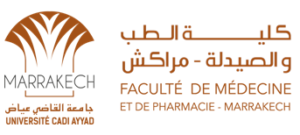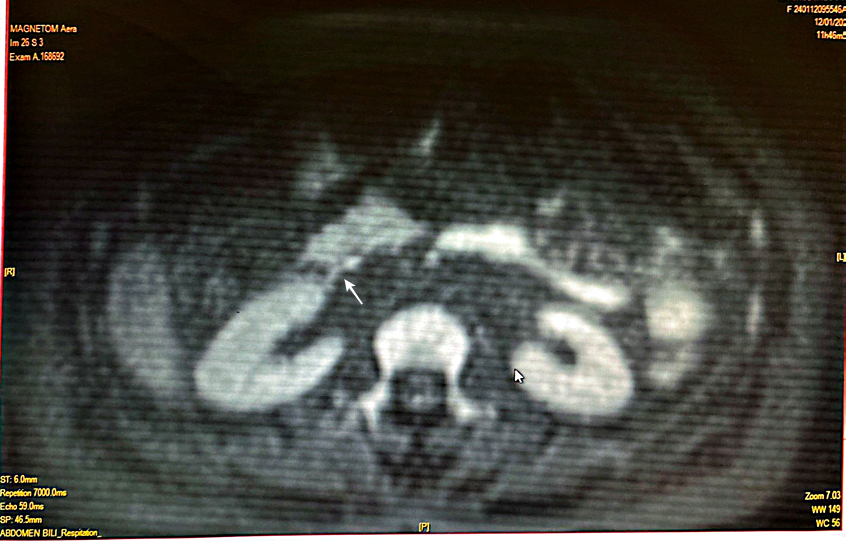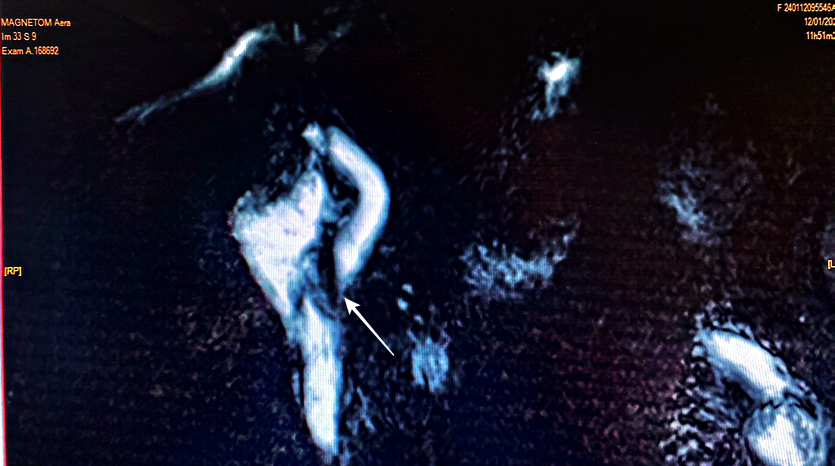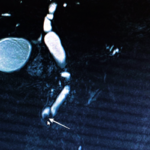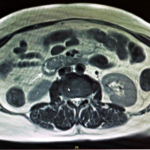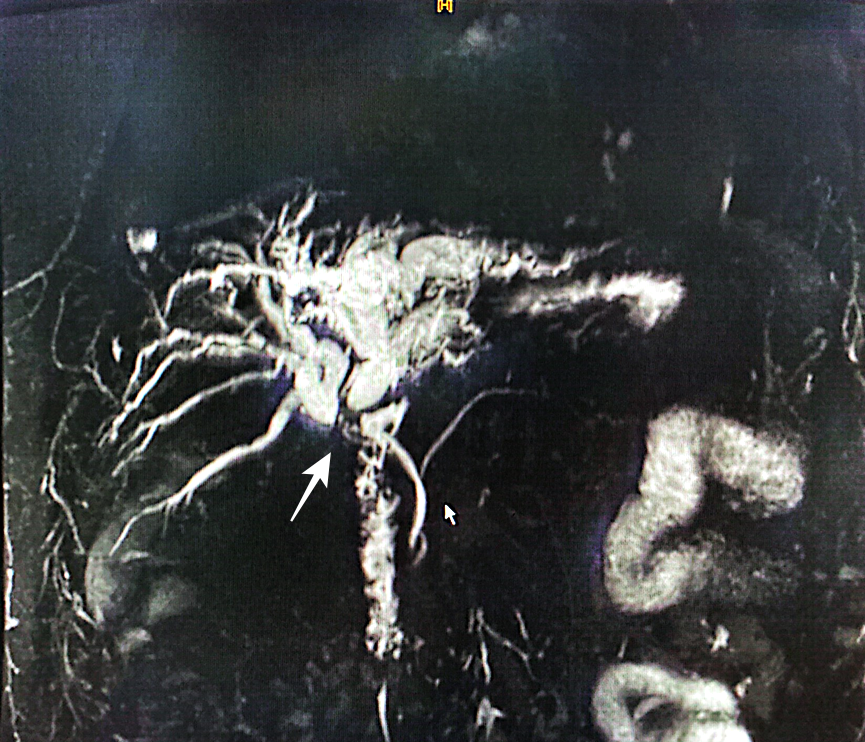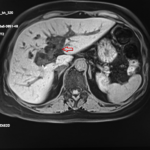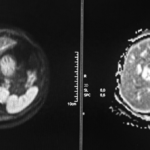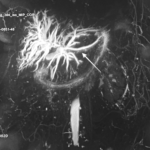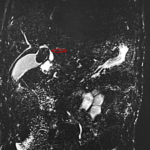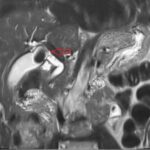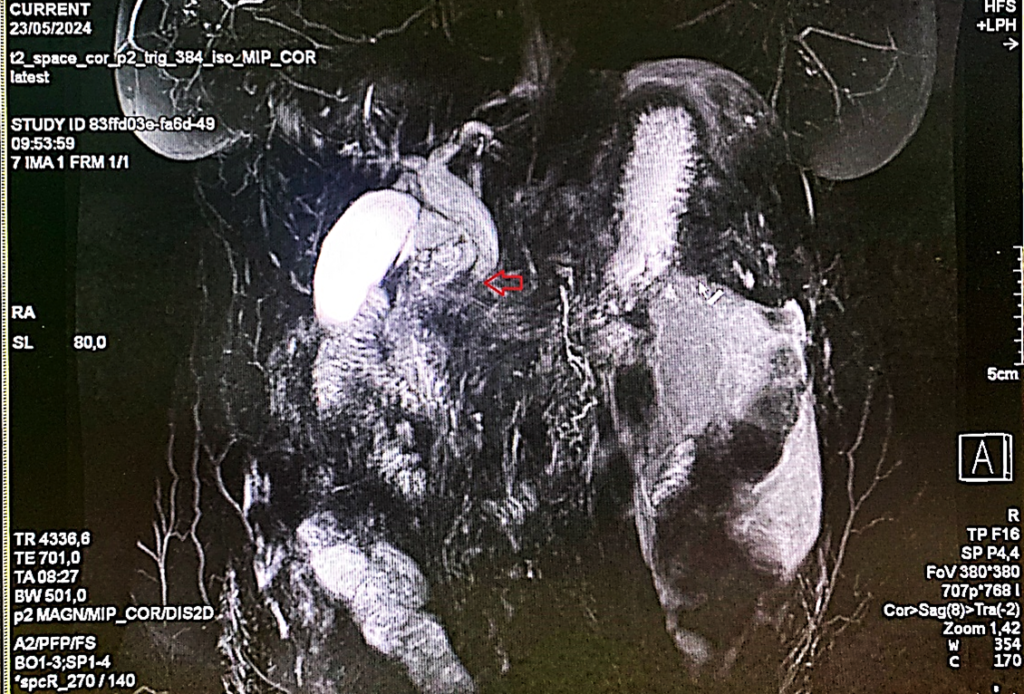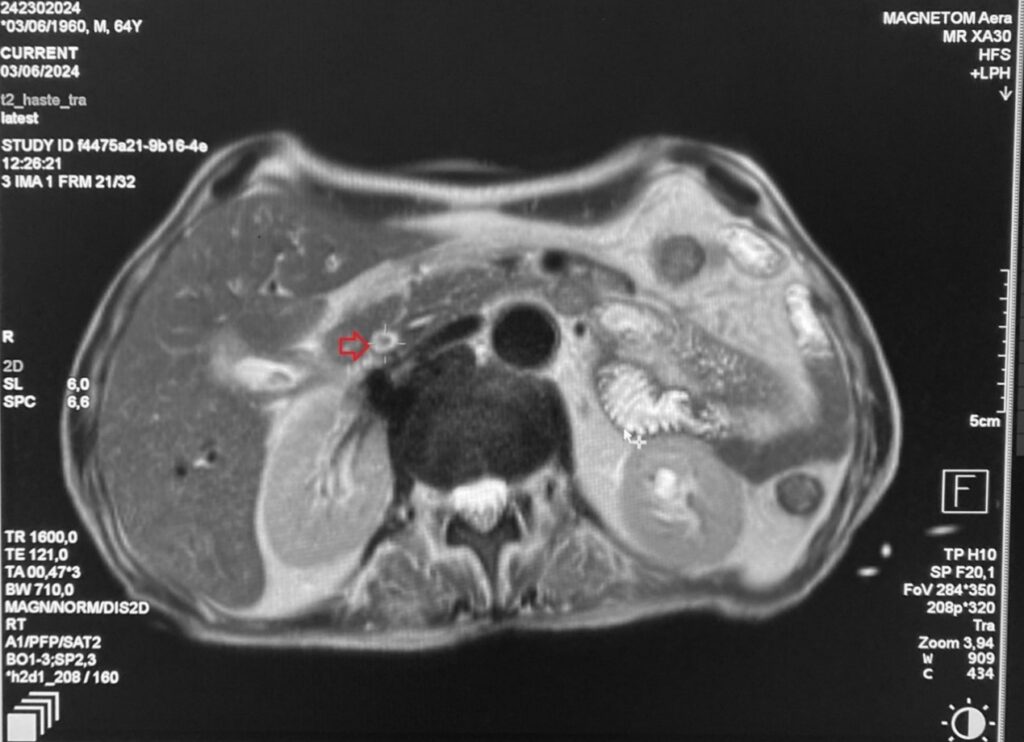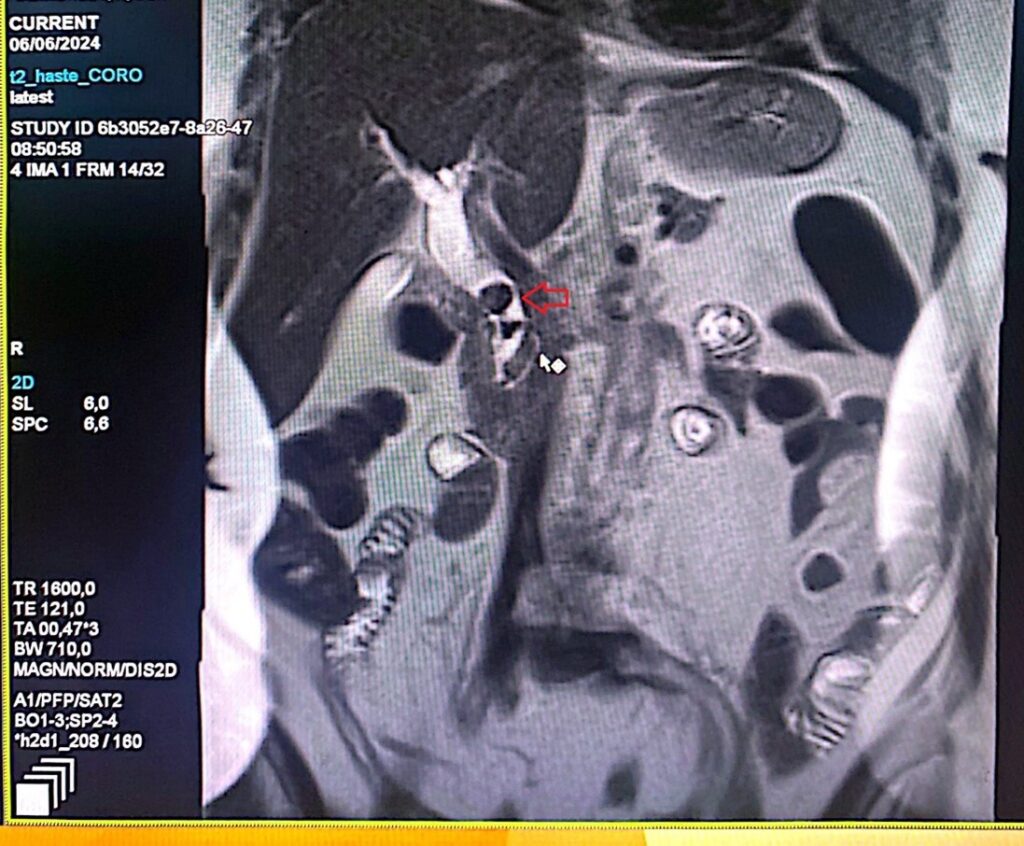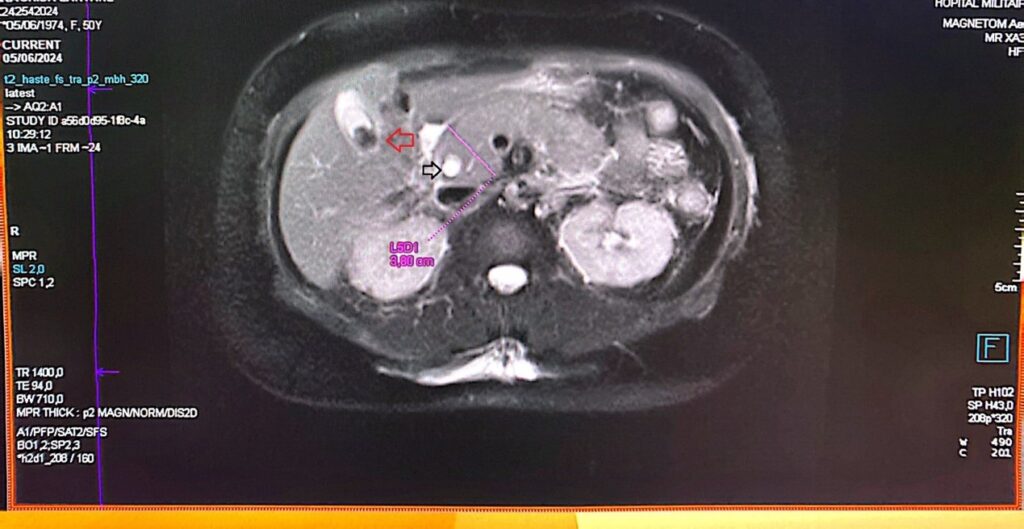Bibliographie :
[1] Standring S, Ananad N, Gray H, Gray H, editors. Gray’s anatomy: the anatomical basis of clinical practice ; [get full access and more at ExpertConsult.com]. 41. ed. Philadelphia, Pa.: Elsevier; 2016.
[2] European Society of Radiology (ESR), Gil Oliveira P, Caseiro-Alves F. eBook for Undergraduate Education in Radiology: Bile ducts 2022. https://doi.org/10.26044/ESR-UNDERGRADUATE-EBOOK-01.
[3] Mortelé KJ, Ros PR. Anatomic Variants of the Biliary Tree: MR Cholangiographic Findings and Clinical Applications. Am J Roentgenol 2001;177:389–94. https://doi.org/10.2214/ajr.177.2.1770389.
[4] Jarrar MS, Masmoudi W, Mraidha MH, Naouar N, Barka M, Youssef S, et al. Anatomic variations of the upper biliary confluence and intra-hepatic ducts in East-central Tunisian population. Ital J Anat Embryol 2020:487-498 Pages. https://doi.org/10.13128/IJAE-11677.
[5] Taghavi et al. – 2017 – Anatomical Variations of the Biliary Tree Found wi.pdf n.d.
[6] El Hariri M, Riad MM. Intrahepatic bile duct variation: MR cholangiography and implication in hepatobiliary surgery. Egypt J Radiol Nucl Med 2019;50:78. https://doi.org/10.1186/s43055-019-0092-x.
[7] Concours-de-résidanat-et-d’internat-appareil-locomoteur-digestif-urogénital.pdf n.d, https://anatomie-fmpm.uca.ma/wp-content/uploads/2020/07/Concours-de-r%C3%A9sidanat-et-d%E2%80%99internat-appareil-locomoteur-digestif-urog%C3%A9nital.pdf
[8] Anatomie Chirurgicale Des Voies Biliaires Extrahépatiques Et de La Jonction Biliopancréatique | PDF | Foie | Vésicule biliaire. Scribd n.d. https://fr.scribd.com/document/519617585/Anatomie-chirurgicale-des-voies-biliaires-extrahepatiques-et-de-la-jonction-biliopancreatique (accessed June 15, 2024).
[9] Standring S, editor. Gray’s anatomy: the anatomical basis of clinical practice. Forty-first edition. New York: Elsevier Limited; 2016.
[10] Di Ciaula A, Wang DQ, Portincasa P. Gallbladder and gastric motility in obese newborns, pre‐adolescents and adults. J Gastroenterol Hepatol 2012;27:1298–305. https://doi.org/10.1111/j.1440-1746.2012.07149.x.
[11] Perret RS, Sloop GD, Borne JA. Common bile duct measurements in an elderly population. J Ultrasound Med Off J Am Inst Ultrasound Med 2000;19:727–30; quiz 731. https://doi.org/10.7863/jum.2000.19.11.727.
[12] Netter FH. Atlas of human anatomy. 5th ed. Philadelphia, PA: Saunders/Elsevier; 2011.
[13] Ampulla of Vater: Comprehensive anatomy, MR imaging of pathologic conditions, and correlation with endoscopy – European Journal of Radiology n.d. https://www.ejradiology.com/article/S0720-048X(07)00194-5/abstract (accessed October 20, 2024).
[14] Hoe L, Gryspeerdt S, Vanbeckevoort D, Jaegere T, Steenbergen W, Dewandel P, et al. Normal Vaterian sphincter complex: Evaluation of morphology and contractility with dynamic single-shot MR cholangiopancreatography. AJR Am J Roentgenol 1998;170:1497–500. https://doi.org/10.2214/ajr.170.6.9609161.
[15] Karaliotas ConCh, Papaconstantinou T, Karaliotas ChCon. Anatomical Variations and Anomalies of the Biliary Tree, Veins and Arteries. In: Karaliotas CCh, Broelsch CE, Habib NA, editors. Liver Biliary Tract Surg., Vienna: Springer Vienna; 2006, p. 35–48. https://doi.org/10.1007/978-3-211-49277-2_3.
[16] Türkvatan A, Erden A, Türkoğlu MA, Yener Ö. Congenital Variants and Anomalies of the Pancreas and Pancreatic Duct: Imaging by Magnetic Resonance Cholangiopancreaticography and Multidetector Computed Tomography. Korean J Radiol 2013;14:905. https://doi.org/10.3348/kjr.2013.14.6.905.
[17] Dimitriou I, Katsourakis A, Nikolaidou E, Noussios G. The Main Anatomical Variations of the Pancreatic Duct System: Review of the Literature and Its Importance in Surgical Practice. J Clin Med Res 2018;10:370. https://doi.org/10.14740/jocmr3344w.
[18] Saidi H, Karanja TM, Ogengo JA. Variant anatomy of the cystic artery in adult Kenyans. Clin Anat 2007;20:943–5. https://doi.org/10.1002/ca.20550.
[19] Standring S, editor. Gray’s anatomy: the anatomical basis of clinical practice. Forty-first edition. New York: Elsevier Limited; 2016.
[20] Northover JMA, Terblanche J. A new look at the arterial supply of the bile duct in man and its surgical implications. Br J Surg 2005;66:379–84. https://doi.org/10.1002/bjs.1800660603.
[21] Rath A, Zhang J, Bourdelat D, Chevrel J. Arterial vascularisation of the extrahepatic biliary tract. Surg Radiol Anat 1993;15:105–11. https://doi.org/10.1007/BF01628308.
[22] Ito M, Mishima Y. Lymphatic drainage of the gallbladder. J Hepatobiliary Pancreat Surg 1994;1:302–8. https://doi.org/10.1007/BF02391086.
[23] Sci-Hub | MR Imaging of the Biliary System. Radiologic Clinics of North America, 52(4), 725–755 | 10.1016/j.rcl.2014.02.011 n.d. https://sci-hub.se/https://pubmed.ncbi.nlm.nih.gov/24889169/ (accessed September 13, 2024).
[24] Jones EA, Bergasa NV. The pruritus of cholestasis. Hepatology 1999;29:1003–6. https://doi.org/10.1002/hep.510290450.
[25] Ramaswamy RS, Choi HW, Mouser HC, Narsinh KH, McCammack KC, Treesit T, et al. Role of interventional radiology in the management of acute gastrointestinal bleeding. World J Radiol 2014;6:82–92. https://doi.org/10.4329/wjr.v6.i4.82.
[26] Tenner S, Baillie J, DeWitt J, Vege SS. American College of Gastroenterology Guideline: Management of Acute Pancreatitis. Am J Gastroenterol 2013;108:1400–15. https://doi.org/10.1038/ajg.2013.218.
[27] Gilliland T, Villafane-Ferriol N, Shah K, Shah R, Tran Cao H, Massarweh N, et al. Nutritional and Metabolic Derangements in Pancreatic Cancer and Pancreatic Resection. Nutrients 2017;9:243. https://doi.org/10.3390/nu9030243.
[28] Tran TB, Norton JA, Ethun CG, Pawlik TM, Buettner S, Schmidt C, et al. Gallbladder Cancer Presenting with Jaundice: Uniformly Fatal or Still Potentially Curable? J Gastrointest Surg Off J Soc Surg Aliment Tract 2017;21:1245–53. https://doi.org/10.1007/s11605-017-3440-z.
[29] Beckingham IJ, Ryder SD. ABC of diseases of liver, pancreas, and biliary system. Investigation of liver and biliary disease. BMJ 2001;322:33–6. https://doi.org/10.1136/bmj.322.7277.33.
[30] Williams R. Sherlock’s disease of the liver and biliary systems. Clin Med 2011;11:506. https://doi.org/10.7861/clinmedicine.11-5-506.
[31] Gunarathne LS, Rajapaksha H, Shackel N, Angus PW, Herath CB. Cirrhotic portal hypertension: From pathophysiology to novel therapeutics. World J Gastroenterol 2020;26:6111–40. https://doi.org/10.3748/wjg.v26.i40.6111.
[32] Kiriyama S, Kozaka K, Takada T, Strasberg SM, Pitt HA, Gabata T, et al. Tokyo Guidelines 2018: diagnostic criteria and severity grading of acute cholangitis (with videos). J Hepato-Biliary-Pancreat Sci 2018;25:17–30. https://doi.org/10.1002/jhbp.512.
[33] Beuers U, Kremer AE, Bolier R, Elferink RPJO. Pruritus in cholestasis: facts and fiction. Hepatol Baltim Md 2014;60:399–407. https://doi.org/10.1002/hep.26909.
[34] Adams DH. Sleisenger and Fordtran’s Gastrointestinal and Liver Disease. Gut 2007;56:1175. https://doi.org/10.1136/gut.2007.121533.
[35] Dancygier H. Clinical Hepatology: Principles and Practice of Hepatobiliary Diseases. Berlin, Heidelberg: Springer Berlin Heidelberg; 2010. https://doi.org/10.1007/978-3-540-93842-2.
[36] Amitrano L, Guardascione MA, Brancaccio V, Balzano A. Coagulation Disorders in Liver Disease. Semin Liver Dis 2002;22:083–96. https://doi.org/10.1055/s-2002-23205.
[37] Li T, Apte U. Bile acid metabolism and signaling in cholestasis, inflammation and cancer. Adv Pharmacol San Diego Calif 2015;74:263–302. https://doi.org/10.1016/bs.apha.2015.04.003.
[38] ACR Appropriateness Criteria® Jaundice – PubMed n.d. https://pubmed.ncbi.nlm.nih.gov/31054739/ (accessed October 29, 2024).
[39] Actualite de la medicine n.d. https://www.angelfire.com/electronic/buibinhtho/radiobiliaire05.htm (accessed September 23, 2024).
[40] PANCREATITE AIGUE n.d. http://memoires.scd.univ-tours.fr/Medecine/Theses/2012_Medecine_ParentNicolas/web/html/indexedac.html?option=com_content&view=article&id=13&Itemid=54 (accessed September 25, 2024).
[41] Garrow D, Miller S, Sinha D, Conway J, Hoffman BJ, Hawes RH, et al. Endoscopic Ultrasound: A Meta-analysis of Test Performance in Suspected Biliary Obstruction. Clin Gastroenterol Hepatol 2007;5:616-623.e1. https://doi.org/10.1016/j.cgh.2007.02.027.
[42] Narrative.pdf n.d, https://acsearch.acr.org/docs/69497/Narrative/
[43] Griffin N, Charles-Edwards G, Grant LA. Magnetic resonance cholangiopancreatography: the ABC of MRCP. Insights Imaging 2011;3:11–21. https://doi.org/10.1007/s13244-011-0129-9.
[44] Ressurreição J, Batista L, Soares JT, Marques I, Matos E, Andrade L, et al. Normal anatomy and anatomic variants of the biliary tree and pancreatic ductal system at MRCP – what the clinicians want to know. ECR 2014 EPOS 2014. https://epos.myesr.org/poster/esr/ecr2014/C-1696 (accessed October 20, 2024).
[45] Mudgal P. Magnetic resonance cholangiopancreatography (MRCP) | Radiology Reference Article | Radiopaedia.org. Radiopaedia n.d. https://doi.org/10.53347/rID-32557.
[46] Laurent V, Corby S, Barbary C, Kermarrec E, Béot S, Régent D. Les nouvelles possibilités d’exploration des voies biliaires en IRM : de l’imagerie morphologique à l’imagerie fonctionnelle avec perfusion de Mangafodipir Trisodium (Mn DPDP). J Radiol 2007;88:531–40. https://doi.org/10.1016/S0221-0363(07)89852-0.
[47] Baillie J, Kimberly J. Prospective comparison of secretin-stimulated MRCP with manometry in the diagnosis of sphincter of Oddi dysfunction types II and III. Gut 2007;56:742–4. https://doi.org/10.1136/gut.2006.111278.
[48] Chopra K, Westaby D, Murray-Lyon I. Why use Buscopan during diagnostic upper gastrointestinal endoscopy? Gut 1996;38:473.
[49] Actualite de la medicine n.d. https://www.angelfire.com/electronic/buibinhtho/radiobiliaire02.htm (accessed September 28, 2024).
[50] Bilgin M, Shaikh F, Semelka RC, Bilgin SS, Balci NC, Erdogan A. Magnetic resonance imaging of gallbladder and biliary system. Top Magn Reson Imaging TMRI 2009;20:31–42. https://doi.org/10.1097/RMR.0b013e3181b48aa2.
[51] Lecesne R, Gense V, Drouillard J. Bili-IRM. Acta Endosc 1998;28:611–6. https://doi.org/10.1007/BF03036222.
[52] Zhong L, Yao Q-Y, Li L, Xu J-R. Imaging diagnosis of pancreato-biliary diseases: A control study. World J Gastroenterol WJG 2003;9:2824. https://doi.org/10.3748/wjg.v9.i12.2824.
[53] Griffin N, Charles-Edwards G, Grant LA. Magnetic resonance cholangiopancreatography: the ABC of MRCP. Insights Imaging 2011;3:11–21. https://doi.org/10.1007/s13244-011-0129-9.
[54] Yam BL, Siegelman ES. MR Imaging of the Biliary System. Radiol Clin North Am 2014;52:725–55. https://doi.org/10.1016/j.rcl.2014.02.011.
[55] Leclerc J, Debelle L, Cannard L, Laurent V. AÉROBILIE ET CP-IRM : INTÉRÊT DES COUPES SAGITTALES. J Radiol n.d.
[56] Bekiesińska-Figatowska M. Artifacts in Magnetic Resonance Imaging. Pol J Radiol 2015;80:93–106. https://doi.org/10.12659/PJR.892628.
[57] Yam BL, Siegelman ES. MR Imaging of the Biliary System. Radiol Clin North Am 2014;52:725–55. https://doi.org/10.1016/j.rcl.2014.02.011.
[58] Van Hoe L, Vanbeckevoort D, Mermuys K, Van Steenbergen W. MR Cholangiopancreatography. Berlin, Heidelberg: Springer Berlin Heidelberg; 2006. https://doi.org/10.1007/3-540-30971-3.
[59] Kubo S, Hamba H, Hirobashi K, Kinoshita H, Lee KC, Yamazaki O, et al. Magnetic Resonance Cholangiography in Hepatolithiasis. | EBSCOhost 1997;92:629. https://openurl.ebsco.com/contentitem/gcd:16018325?sid=ebsco:plink:crawler&id=ebsco:gcd:16018325 (accessed October 12, 2024).
[60] Bellamlih H, Bouimetarhan L, En-nouali H, Amil T, Chouaib N, Jidane S, et al. Le syndrome de Mirizzi: une cause rare de l’obstruction des voies biliaires: à propos d’un cas et revue de littérature. Pan Afr Med J 2017;27:45. https://doi.org/10.11604/pamj.2017.27.45.12469.
[61] Clemente G, Tringali A, De Rose AM, Panettieri E, Murazio M, Nuzzo G, et al. Mirizzi Syndrome: Diagnosis and Management of a Challenging Biliary Disease. Can J Gastroenterol Hepatol 2018;2018:1–6. https://doi.org/10.1155/2018/6962090.
[62] Cholangiocarcinoma. A spectrum of intrahepatic, perihilar, and distal tumors – PubMed n.d. https://pubmed.ncbi.nlm.nih.gov/8857851/ (accessed October 23, 2024).
[63] Hamrick-Turner J, Abbitt PL, Ros PR. Intrahepatic cholangiocarcinoma: MR appearance. Am J Roentgenol 1992;158:77–9. https://doi.org/10.2214/ajr.158.1.1309221.
[64] Blechacz B, Komuta M, Roskams T, Gores G. Clinical diagnosis and staging of cholangiocarcinoma. Nat Rev Gastroenterol Hepatol 2011;8:512–22. https://doi.org/10.1038/nrgastro.2011.131.
[65] Kubo S, Shinkawa H, Asaoka Y, Ioka T, Igaki H, Izumi N, et al. Liver Cancer Study Group of Japan Clinical Practice Guidelines for Intrahepatic Cholangiocarcinoma. Liver Cancer 2022;11:290–314. https://doi.org/10.1159/000522403.
[66] Masselli G, Gualdi G. Hilar cholangiocarcinoma: MRI/MRCP in staging and treatment planning. Abdom Imaging 2008;33:444–51. https://doi.org/10.1007/s00261-007-9281-6.
[67] Han JK, Choi BI, Kim AY, An SK, Lee JW, Kim TK, et al. Cholangiocarcinoma: Pictorial Essay of CT and Cholangiographic Findings. RadioGraphics 2002;22:173–87. https://doi.org/10.1148/radiographics.22.1.g02ja15173.
[68] Lecesne R, Gense V, Drouillard J. Bili-IRM. Acta Endosc 1998;28:611–6. https://doi.org/10.1007/BF03036222.
[69] Jeong HT, Kim M-J, Chung YE, Choi JY, Park YN, Kim KW. Gadoxetate disodium-enhanced MRI of mass-forming intrahepatic cholangiocarcinomas: imaging-histologic correlation. AJR Am J Roentgenol 2013;201:W603-611. https://doi.org/10.2214/AJR.12.10262.
[70] Choi SH, Lee SS, Kim SY, Park SH, Park SH, Kim KM, et al. Intrahepatic Cholangiocarcinoma in Patients with Cirrhosis: Differentiation from Hepatocellular Carcinoma by Using Gadoxetic Acid-enhanced MR Imaging and Dynamic CT. Radiology 2017;282:771–81. https://doi.org/10.1148/radiol.2016160639.
[71] Wang J, Takashima S, Takayama F, Kawakami S, Saito A, Matsushita T, et al. Head and neck lesions: characterization with diffusion-weighted echo-planar MR imaging. Radiology 2001;220:621–30. https://doi.org/10.1148/radiol.2202010063.
[72] Holzapfel K, Gaa J, Schubert EC, Eiber M, Kleeff J, Rummeny EJ, et al. Value of diffusion-weighted MR imaging in the diagnosis of lymph node metastases in patients with cholangiocarcinoma. Abdom Radiol 2016;41:1937–41. https://doi.org/10.1007/s00261-016-0791-y.
[73] Lee S, Cherqui D. Operative Management of Cholangiocarcinoma. Semin Liver Dis 2013;33:248–61. https://doi.org/10.1055/s-0033-1351784.
[74] Kumar A, Mohanty NR, Mohanty M, Dash S. Comparison of MRCP and ERCP in the evaluation of common bile duct and pancreatic duct pathologies. Front Med Technol 2023;5:946555. https://doi.org/10.3389/fmedt.2023.946555.
[75] Ahualli J. The Double Duct Sign. Radiology 2007;244:314–5. https://doi.org/10.1148/radiol.2441041978.
[76] Lauenstein TC, Martin DR, Sarmiento JM, Kalb B, Moreira R, Carew J, et al. Pancreatic Adenocarcinoma Tumor Grade Determination Using Contrast-Enhanced Magnetic Resonance Imaging. Pancreas 2010;39:71. https://doi.org/10.1097/MPA.0b013e3181b9ed55.
[77] Mergo PJ, Helmberger TK, Buetow PC, Helmberger RC, Ros PR. Pancreatic neoplasms: MR imaging and pathologic correlation. RadioGraphics 1997;17:281–301. https://doi.org/10.1148/radiographics.17.2.9084072.
[78] Johnston A, Serhal A, Lopes Vendrami C, McCarthy RJ, Komanduri S, Horowitz JM, et al. The abrupt pancreatic duct cutoff sign on MDCT and MRI. Abdom Radiol 2020;45:2476–84. https://doi.org/10.1007/s00261-020-02582-8.
[79] Anderson MA, Knipp DE, Noda Y, Kamran SC, Baliyan V, Kordbacheh H, et al. MRI-Based Tumor Necrosis Depiction in Pancreatic Ductal Adenocarcinoma: Can It Predict Tumor Aggressiveness? Cancers 2023;15:2313. https://doi.org/10.3390/cancers15082313.
[80] Zaborienė I, Strakšytė V, Ignatavičius P, Barauskas G, Dambrauskienė R, Žvinienė K. Dynamic Contrast-Enhanced Magnetic Resonance Imaging for Measuring Perfusion in Pancreatic Ductal Adenocarcinoma and Different Tumor Grade: A Preliminary Single Center Study. Diagnostics 2023;13:521. https://doi.org/10.3390/diagnostics13030521.
[81] Diffusion-weighted imaging of pancreatic cancer – PMC n.d. https://www.ncbi.nlm.nih.gov/pmc/articles/PMC4620112/ (accessed October 14, 2024).
[82] Chen W-X, Xie Q-G, Zhang W-F, Zhang X, Hu T-T, Xu P, et al. Multiple imaging techniques in the diagnosis of ampullary carcinoma. Hepatobiliary Pancreat Dis Int HBPD INT 2008;7:649–53.
[83] Semelka RC, Kelekis NL, John G, Ascher SM, Burdeny D, Siegelman ES. Ampullary carcinoma: Demonstration by current MR techniques. J Magn Reson Imaging 1997;7:153–6. https://doi.org/10.1002/jmri.1880070122.
[84] Irie H, Honda H, Shinozaki K, Yoshimitsu K, Aibe H, Nishie A, et al. MR Imaging of Ampullary Carcinomas: J Comput Assist Tomogr 2002;26:711–7. https://doi.org/10.1097/00004728-200209000-00008.
[85] Kamat R, Gupta P, Rana S. Imaging in chronic pancreatitis: State of the art review. Indian J Radiol Imaging 2019;29:201. https://doi.org/10.4103/ijri.IJRI_484_18.
[86] Ichikawa T, Sou H, Araki T, Arbab AS, Yoshikawa T, Ishigame K, et al. Duct-penetrating Sign at MRCP: Usefulness for Differentiating Inflammatory Pancreatic Mass from Pancreatic Carcinomas. Radiology 2001;221:107–16. https://doi.org/10.1148/radiol.2211001157.
[87] Sarner M, Cotton PB. Classification of pancreatitis. Gut 1984;25:756–9. https://doi.org/10.1136/gut.25.7.756.
[88] Choueiri NE, Balci NC, Alkaade S, Burton FR. Advanced imaging of chronic pancreatitis. Curr Gastroenterol Rep 2010;12:114–20. https://doi.org/10.1007/s11894-010-0093-4.
[89] Hafezi-Nejad N, Singh V, Johnson S, Makary M, Hirose K, Fishman E, et al. Surgical approaches to chronic pancreatitis: indications and imaging findings. Abdom Radiol 2016;41. https://doi.org/10.1007/s00261-016-0775-y.
[90] Ito K, Mitchell DG, Outwater EK, Blasbalg R. Primary sclerosing cholangitis: MR imaging features. AJR Am J Roentgenol 1999;172:1527–33. https://doi.org/10.2214/ajr.172.6.10350284.
[91] Düşünceli E, Erden A, Erden I, Karayalçin S. Primary sclerosing cholangitis: MR cholangiopancreatography and T2-weighted MR imaging findings. Diagn Interv Radiol Ank Turk 2005;11:213–8.
[92] Arrivé L, Ruiz A, El Mouhadi S, Azizi L, Monnier-Cholley L, Menu Y. MRI of cholangitis: Traps and tips. Diagn Interv Imaging 2013;94:757–70. https://doi.org/10.1016/j.diii.2013.03.006.
[93] Elsayes KM, Oliveira EP, Narra VR, Abou El Abbass HA, Ahmed MI, Tongdee R, et al. MR and MRCP in the evaluation of primary sclerosing cholangitis: current applications and imaging findings. J Comput Assist Tomogr 2006;30:398–404. https://doi.org/10.1097/00004728-200605000-00009.
[94] Ruemmele P, Hofstaedter F, Gelbmann CM. Secondary sclerosing cholangitis. Nat Rev Gastroenterol Hepatol 2009;6:287–95. https://doi.org/10.1038/nrgastro.2009.46.
[95] pathologie-des-VBIH-en-CPIRM-FER-2000.pdf n.d, https://onclepaul.net/wp-content/uploads/2011/07/pathologie-des-VBIH-en-CPIRM-FER-2000.pdf
[96] Tonolini M, Bianco R. HIV-related/AIDS cholangiopathy: pictorial review with emphasis on MRCP findings and differential diagnosis. Clin Imaging 2013;37:219–26. https://doi.org/10.1016/j.clinimag.2012.03.008.
[97] Imagerie du carrefour biliopancréatique – EM consulte n.d. https://www.em-consulte.com/article/23157/imagerie-du-carrefour-biliopancreatique (accessed October 19, 2024).
[98] Batts KP. Ischemic cholangitis. Mayo Clin Proc 1998;73:380–5. https://doi.org/10.1016/S0025-6196(11)63706-3.
[99] Kemeny MM, Battifora H, Blayney DW, Cecchi G, Goldberg DA, Leong LA, et al. Sclerosing cholangitis after continuous hepatic artery infusion of FUDR. Ann Surg 1985;202:176–81. https://doi.org/10.1097/00000658-198508000-00007.
[100] Belghiti J, Benhamou JP, Houry S, Grenier P, Huguier M, Fékété F. Caustic sclerosing cholangitis. A complication of the surgical treatment of hydatid disease of the liver. Arch Surg Chic Ill 1960 1986;121:1162–5. https://doi.org/10.1001/archsurg.1986.01400100070014.
[101] Erden A, Ormeci N, Fitoz S, Erden I, Tanju S, Genç Y. Intrabiliary rupture of hepatic hydatid cysts: diagnostic accuracy of MR cholangiopancreatography. AJR Am J Roentgenol 2007;189:W84-89. https://doi.org/10.2214/AJR.07.2068.
[102] Martí-Bonmatí L, Menor F, Ballesta A. Hydatid cyst of the liver: rupture into the biliary tree. AJR Am J Roentgenol 1988;150:1051–3. https://doi.org/10.2214/ajr.150.5.1051.
[103] Mendez Montero JV, Arrazola Garcia J, Lopez Lafuente J, Antela Lopez J, Mendez Fernandez R, Saiz Ayala A. Fat-fluid level in hepatic hydatid cyst: a new sign of rupture into the biliary tree? AJR Am J Roentgenol 1996;167:91–4. https://doi.org/10.2214/ajr.167.1.8659428.
[104] Khuroo MS, Zargar SA. Biliary ascariasis. A common cause of biliary and pancreatic disease in an endemic area. Gastroenterology 1985;88:418–23.
[105] Ding ZX, Yuan JH, Chong V, Zhao DJ, Chen FH, Li YM. 3 T MR cholangiopancreatography appearances of biliary ascariasis. Clin Radiol 2011;66:275–7. https://doi.org/10.1016/j.crad.2010.11.004.
[106] Hashmi MA, De JK. Biliary Ascariasis on Magnetic Resonance Cholangiopancreatography. J Glob Infect Dis 2009;1:144. https://doi.org/10.4103/0974-777X.56248.
[107] Smith AD, Mohammed F, Watson GMT, Howlett DC. Common bile duct compression by an abdominal aortic aneurysm: an unusual cause of biliary tract dilatation. Eur J Gastroenterol Hepatol 2002;14:767–9. https://doi.org/10.1097/00042737-200207000-00009.
[108] Bayraktar Y, Balkanci F, Kayhan B, Ozenç A, Arslan S, Telatar H. Bile duct varices or “pseudo-cholangiocarcinoma sign” in portal hypertension due to cavernous transformation of the portal vein. Am J Gastroenterol 1992;87:1801–6.
[109] Ito Y, Miyauchi M, Nakamura T, Takahara N, Nakai Y, Taoka K, et al. Significance of biopsy with ERCP for diagnosis of bile duct invasion of DLBCL. Int J Hematol 2019;110:381–4. https://doi.org/10.1007/s12185-019-02661-7.
[110] Haider A, Siddiqa A, Ali N, Mehershahi S. Biliary Sphincter of Oddi Dysfunction. Case Rep Gastroenterol 2021;15:443. https://doi.org/10.1159/000514542.
[111] Abdelgawad MS, Eid M, Abokoura S, Elmazaly MA, Aly RA. Iatrogenic bile duct injuries after laparoscopic cholecystectomy: evaluation by MRCP before management. Egypt Liver J 2023;13:2. https://doi.org/10.1186/s43066-023-00238-y.
[112] Khalid TR, Casillas VJ, Montalvo BM, Centeno R, Levi JU. Using MR Cholangiopancreatography to Evaluate Iatrogenic Bile Duct Injury. Am J Roentgenol 2001;177:1347–52. https://doi.org/10.2214/ajr.177.6.1771347.
[113] Yeh T-S, Jan Y-Y, Tseng J-H, Hwang T-L, Jeng L-B, Chen M-F. Value of magnetic resonance cholangiopancreatography in demonstrating major bile duct injuries following laparoscopic cholecystectomy. Br J Surg 1999;86:181–4. https://doi.org/10.1046/j.1365-2168.1999.01029.x.
[114] Chardot C. Atrésie des voies biliaires : actualités. Arch Pédiatrie 2003;10:s52–4. https://doi.org/10.1016/S0929-693X(03)90379-4.
[115] Peng SS, Li YW, Chang MH, Ni YH, Su CT. Magnetic resonance cholangiography for evaluation of cholestatic jaundice in neonates and infants. J Formos Med Assoc Taiwan Yi Zhi 1998;97:698–703.
[116] Jaw T-S, Kuo Y-T, Liu G-C, Chen S-H, Wang C-K. MR Cholangiography in the Evaluation of Neonatal Cholestasis. Radiology 1999;212:249–56. https://doi.org/10.1148/radiology.212.1.r99jl13249.
[117] Lall NU, Hogan MJ. Caroli disease and the central dot sign. Pediatr Radiol 2009;39:754. https://doi.org/10.1007/s00247-009-1147-3.
[118] Khalefa AA, Alrasheed M, Saeedan MB. Central dot sign. Abdom Radiol N Y 2016;41:2289–90. https://doi.org/10.1007/s00261-016-0836-2.
[119] Desmet VJ. Congenital diseases of intrahepatic bile ducts: variations on the theme “ductal plate malformation.” Hepatol Baltim Md 1992;16:1069–83. https://doi.org/10.1002/hep.1840160434.
[120] Hartung MP. Caroli disease | Radiology Case | Radiopaedia.org. Radiopaedia n.d. https://doi.org/10.53347/rID-94559.

